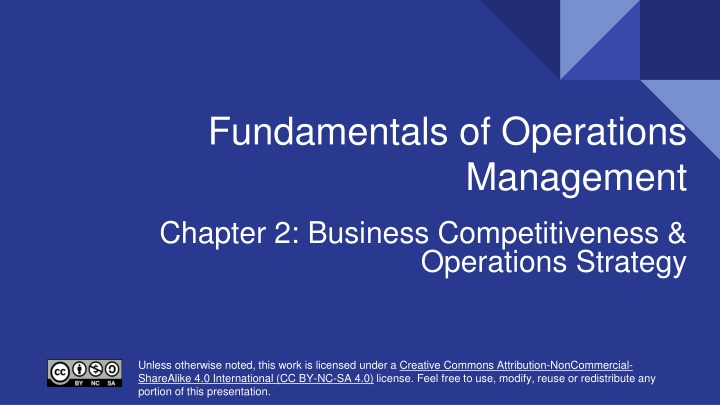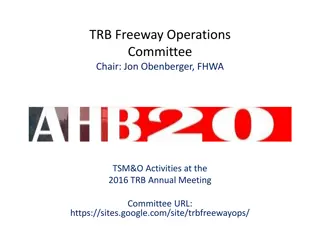
Business Competitiveness and Operations Strategy
Explore the dynamics of modern business environments, key players influencing decisions, competitiveness factors, achieving competitive advantage, and the importance of operational strategies in driving business success.
Download Presentation

Please find below an Image/Link to download the presentation.
The content on the website is provided AS IS for your information and personal use only. It may not be sold, licensed, or shared on other websites without obtaining consent from the author. If you encounter any issues during the download, it is possible that the publisher has removed the file from their server.
You are allowed to download the files provided on this website for personal or commercial use, subject to the condition that they are used lawfully. All files are the property of their respective owners.
The content on the website is provided AS IS for your information and personal use only. It may not be sold, licensed, or shared on other websites without obtaining consent from the author.
E N D
Presentation Transcript
Fundamentals of Operations Management Chapter 2: Business Competitiveness & Operations Strategy Creative Commons Attribution-NonCommercial-ShareAlike 4.0 International (CC BY-NC-SA 4.0) Creative Commons Attribution-NonCommercial-ShareAlike 4.0 International (CC BY-NC-SA 4.0) Unless otherwise noted, this work is licensed under a Creative Commons Attribution-NonCommercial- ShareAlike 4.0 International (CC BY-NC-SA 4.0) license. Feel free to use, modify, reuse or redistribute any portion of this presentation.
2.0 Learning Outcomes In this chapter, we will: Explore the modern environment of business and the key players that can influence business decisions. Explain the factors that influence purchasing decisions. Differentiate between essential criteria for being considered as a supplier (order qualifiers) and criteria that give a competitive edge (order winners). Identify the four main priorities (cost, quality, speed, and flexibility) and the strategies firms use to achieve them. Describe the concept of core competency, which refers to a company s unique strengths and capabilities. Explain the three levels of strategy corporate, business, and functional. Describe the six categories of operations strategy, such as cost, quality, and innovation.
2.1 Modern Environment of Business The business environment is dynamic and involves various players impacting decision-making. Players like ISO, financial institutions, environmental activists, and others influence business operations. Key players include suppliers, competitors, customers, and regulatory bodies. Businesses aim to win more customers amidst competition to expand market share and increase profit. Success hinges on understanding external influences and maintaining competitiveness.
2.2 Competitiveness Competitiveness refers to a firm s ability and performance in selling and supplying goods and services within a given market. It s about how a company can win over customers to become their preferred choice. Competitive Advantage is achieved by offering better value than competitors through lower prices or higher quality. Key purchasing criteria include price, quality, variety, and timeliness. Customer decisions are influenced by these criteria when choosing a service or product.
2.2 Competitive advantage Lower Prices Competitive advantage is what makes a business stand out from its competitors. Comes in many forms, such as lower prices, higher quality, better customer service, and unique features. Some companies can offer a similar product at a cheaper cost due to efficiencies or economies of scale. Higher quality Some companies focus on building superior products that last longer or perform better. Better customer service Companies that prioritize customer experience can build loyalty through strong support. Unique features A groundbreaking product or service can create a competitive advantage if it fills a specific customer need.
2.2 Key Purchasing Criteria Price How much does the product cost compared to competitors? Key Purchasing Criteria are the factors that influence a customer s buying decision. Businesses can tailor their marketing and sales to resonate with a customer s key purchasing criteria. Quality Will the product be long lasting and defect free? Variety Are there different options or styles for the product? Timeliness Can the product be delivered in a timely manner?
2.2 Competitiveness (cont.) Two essential concepts related to purchasing criteria are order qualifiers: the non-negotiable features or requirements that customers expect, and order winners: differentiate a product or service and lead to winning the Customer s order. Operations management involves balancing trade-offs like cost vs. quality and flexibility vs. speed. Companies must decide what matters most to their customers and focus on excelling in those areas. Core competencies are unique strengths and talents that give a company a competitive edge. Successful companies identify and leverage their core competencies, such as skilled employees, specialized equipment, or a strong brand reputation. Understanding and exploiting core competencies helps businesses stand out and succeed in their industry.
2.3 Strategy Business strategy entails establishing long-term goals and outlining a course of action for a firm, differentiating it from the day-to-day operational activities. Winning market share requires a strategy that aligns operations with customer needs, despite complexities and changes. Operations strategy is based on external demands but executed internally, using top-down or bottom-up approaches. The strategic hierarchy includes corporate strategy (broad vision), business- level strategy (competitive approaches), functional strategies (department plans), and operational strategy (daily activities). Corporate strategy sets core values and competitive advantage, guiding business units in achieving success through cost leadership, differentiation, or focus. Functional and operational strategies support business goals, ensuring coordinated decision-making and efficient resource use.
2.3 Critical Decisions in Operations Strategy Process and Capacity Design: Optimal process depends on product type, volume, and variety. Product and Service Design Quality Management: Location Strategy: Layout Design: Design affects costs and quality; materials and functionality are key. Ensures consistent quality using SPC, TQM, or Six Sigma. Facility placement impacts production speed and delivery Position workstations to minimize waste and maximize efficiency. Human Inventory Management: Supply Chain Management: Maintenance: Scheduling: Resources and Job Design: Balance training, motivation, and task efficiency. Regular upkeep minimizes downtime and maintains quality. Ensures timely deliveries by balancing workload and resources. Balance material availability with holding costs. Supplier location and collaboration affect cost and speed.
2.3 Common Operations Strategies Operations strategy includes quality-based and time-based approaches for a competitive edge. Quality-based strategies Time-based strategies ISO 9001: An international standard for quality management systems ensuring consisten product quality and customer satisfaction. Customer Satisfaction: Faster deliveries enhance customer satisfaction, encouraging repeat business and positive word-of-mouth. Six Sigma: A data-driven methodology aimed at eliminating defects in processes to improve quality and efficiency. Inventory Costs: Streamlined processes reduce inventory and associated costs. Total Quality Management (TQM): A holistic approach emphasizing continuous improvement and a pervasive culture of quality throughout the organization. Responsiveness to Market Shifts: Shorter lead times enable rapid adaptation to market changes and quicker product updates.
2.4 The Power of Productivity Measurement Material Productivity Units of output per dollar spent on materials Dollars of output per dollar spent on materials Dollars of output per unit of material input Machine Productivity Output per machine Units of output per machine hour Output per machine centre Labour Productivity Dollars of output per labour hour Units of output per labour dollar Units of output per shift Energy Productivity Units of output per gallon of water Dollars of output per dollar of hydro Dollars of output per kilowatt hour Productivity is a relative measure, compared over time or against competitors to assess improvement or decline. Output measurement varies based on product nature, with homogenous goods measured by units produced and diverse products often by dollar value. Inputs are typically measured in dollars spent, with exceptions like labor hours, water usage, or electricity consumption. Productivity is commonly assessed for significant expenditures, such as meat output compared to feed consumption in farming.
2.4 Calculating Percent Change Once you ve chosen the appropriate productivity measure, you can calculate the percent change over a specific period. If the result is positive, it is an increase. If the result is negative, it is a decrease. Here s the formula: Percent Change in Productivity = ((New Period Productivity Old Period Productivity) Old Period Productivity) 100 Multi-factor Productivity Partial Productivity Total Productivity PP = Output Labour MFP = Output (Labour + Materials) TP = Output All Inputs PP = Output Energy MFP = Output (Energy + Labour + Materials) PP = Output Materials
2.5 Summary & Review The chapter explores the modern business environment's impact on competitiveness, highlighting the need for firms to navigate various influences. Competitiveness is defined by a firm's ability to offer better value than competitors, focusing on price, quality, variety, and timeliness. Key purchasing criteria include order qualifiers and order winners, which businesses must leverage to attract customers. Competitive priorities cost, quality, flexibility, and speed require trade-offs, as excelling in one area may compromise another. Core competencies are crucial for sustaining competitive advantage, meeting specific criteria like delivering superior value and being difficult to imitate. The strategic hierarchy from corporate to operational levels emphasizes aligning strategies to achieve overall business goals, with critical decisions in operations strategy like product design and supply chain management requiring careful planning and execution.


















